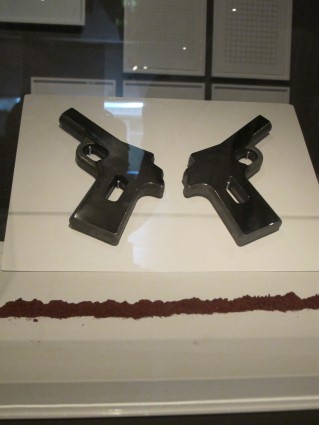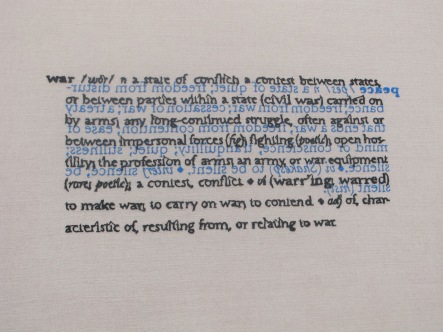I was keen to attend this study day as I had enjoyed and benefited greatly from the other study days I had attended. I was also hoping to see some of Cornelia Parkers exhibition, though the itinerary for the day looked pretty tight, so I wasn’t sure I’d see much. As it happened we had the free rein to explore the gallery in the morning, so after a quick look around the gallery I found Parker’s, exhibits. I wanted to see if she had included any of her ‘Pornographic drawings’ as I was referencing them in the Exploring ideas course. The first thing my eyes focussed on was indeed one of those images. Pornographic drawings are prints made using confiscated pornographic films given by H.M Customs, mixed with chemicals which melt the celluloid film into a substance Parker then make prints with. She used the method that produces images in the manner of Rorschach psychological ink blots.
I am a great fan of Parkers work, only discovering her work since I began studying with the OCA. In all I spent 3 hours with her exhibition and found it immensely interesting, inspiring and also I found confidence to pursue my idea of printing using blood. in fact Parker had used her own blood in producing her ‘self portrait’ images which consisted of four images, one square, one circle, one triangle and one single line drawn with blood.
I cannot say there was one exhibit that I didn’t find fascinating or inspiring in Parkers’ exhibition, nor was there one that I had a preference for. I do find her method of taking one item and through changing it to create another, working in an al-chemical method was most fascinating.
Other pieces were embroidered texts which are similar in execution to the Magna Carta piece that is on show at the moment at the British Library, London. A link to an article about the Magna Carta embroidery is available HERE
In all I have taken away many things from this exhibition namely, an enthusiasm to push myself to work with a variety of materials, that I can and wish to work with large-scale pieces and most importantly for me that ‘samples’ are valid and valuable as pieces. Most of the works in Parkers’ exhibition were titled as being samples and this struck me like a bolt out of the blue. I have always considered samples as being the poor relation, and often necessary evil on the road to producing a piece. I now see them as items of beauty and considerable value.
The afternoon of the study visit was spent in the study room looking at archived work from a range of artists. We were able to handle them, photograph and enjoy them at close hand, discussing the pieces with other students was a fabulous opportunity to explore what each saw and discuss of how they were made. In doing this I felt we actually got more from seeing them than if we were individuals viewing. We all had a starting point which was usually a familiar practice in our own making, which when in conversation with others we found and understood far more about the piece.
An additional bonus to me was the glancing of a name next to a set of drawers. I recognised in passing Anish Kapoor, a favourite artist of mine and again someone I have referenced in my work on part 2 of the Exploring ideas course. As I got to look through the drawers which contained numerous works of his I came across the piece I referenced. The image isn’t the best but given the lighting it was the best I could do. I was star struck at seeing an actual piece of art by Kapoor so even in its shadow ridden state this image is very special to me.














